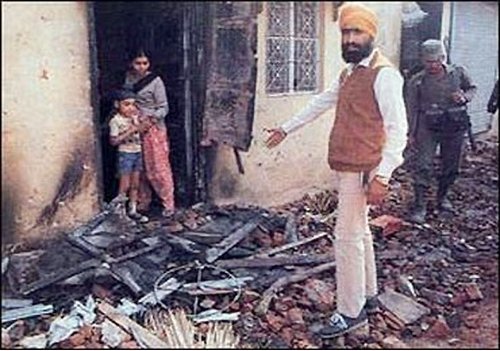The year 1984 was very tragic and traumatic for Sikhs, as they had to endure gruesome attacks in both June and November. Sikhs around the world should work to keep the memories of 1984 alive, so tragedies like these will not be repeated. This handout will share a dialogue about the November 1984 Sikh Genocide.
What happened to Sikhs in November of 1984?
In the first week of November 1984, thousands of Sikhs were massacred in India’s capital city, New Delhi, as well as in other parts of India. Sikh women were gang raped, thousands of children orphaned, and Sikh residences, businesses and religious institutions were ransacked and destroyed in an organized manner with the open complicity of political and civil authorities.

How was the Sikh Genocide executed?
The Sikh Genocide was planned as the mobs of thousands were well equipped with uniform size iron rods, restricted inflammable powder, kerosene and petrol. Killer mobs targeted Sikhs with the help of official records.

What was the role of the State during the Sikh Genocide?
The state owned and controlled media was instigating mobs to take hostile action against Sikhs. Politicians such as Jagdish Tytler were leading mobs to hunt Sikhs. The police did not take any action to defend the Sikhs, and instead worked in unison with the killers in many places. The executive branch did not request for help from the army even though it was available nearby. The state deliberately failed its citizens.

Can the killings of the Sikhs be termed as riots?
NO — this was genocide because only Sikhs were killed in a systematic and planned manner. Sikh men, women, and children were targeted for their religion and distinctive appearance so it should be called a Sikh Genocide as defined in Article 2 of The United Nations Convention on the Prevention and Punishment of the Crime of Genocide.

Has justice been served to Sikhs in the biggest democracy of the world?
NO — since 1984, justice has been deliberately delayed and denied to Sikhs. Even after the establishment of ten State Commissions to investigate the November 1984 Sikh Genocide, the culprits are free and enjoying powerful political and state positions. On the other hand, Sikh victims of this genocide are dying awaiting justice. Due to the state’s failure to punish the culprits of the 1984 Sikh Genocide, Muslims in Ayodhya, U.P. (1992), and Ahmedabad, Gujarat (2002) as well as Christians in Kandhmal, Orrisa (2008) have become victims of other massacres. The existence of minorities in India is clearly threatened.

How have the Sikhs responded to this genocide?
Sikhs all over the world have responded in their own ways. They are still fighting for justice. Sikh institutions and media have highlighted this genocide; articles, books and movies have been produced and candle vigils are being held. A “One Minute of Silence” at 6:00 pm on November 1st is being observed every year. Sikhs from Canada have started the Blood Donation Campaign to commemorate the memory of the victims of Sikh Genocide and have saved more than 55 thousand precious lives in Canada. After North America and Australia, this life saving campaign against genocidal mindset is spreading around the world. Sikh Nation requests all the justice and peace loving people of the world to become a part of this humanitarian campaign. Human rights violations should never be condoned.


